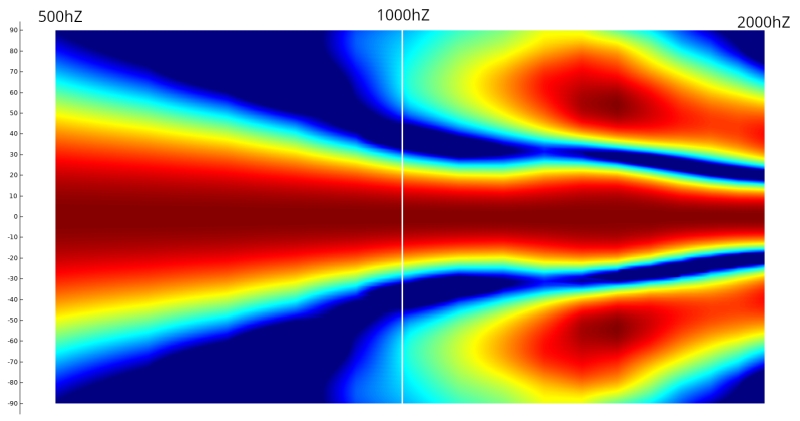The Center-to-Center Conundrum: Why Distance Matters in Speaker Design
Introduction
When it comes to crafting the perfect speaker, meticulous attention is paid to every detail, from the materials used to the precise arrangement of the drivers.
One crucial factor, often overlooked, is the center-to-center distance between the mid-woofers and the tweeter section.
Placing them too close together can create a phenomenon known as vertical lobing, negatively impacting sound quality.
Understanding Vertical Lobing
Imagine sound waves as ripples emanating from a speaker in all directions. When two driver sections – like woofers – are positioned too close, their sound waves can interact, causing cancellation at specific frequencies.
This cancellation creates dips and peaks in the off-axis frequency response, resulting in an uneven and disjointed listening experience by degrading power response.
Especially because we listen at the so called critical distance where direct and reflected sound (from walls) are roughly balanced (50/50).
Think of a speaker with a single woofer. The sound it produces spreads uniformly in a vertical plane, like cutting a cake in half. Now, add another woofer positioned too close. At specific frequencies, the sound waves from each woofer will overlap and partially cancel each other out, especially above and below the speaker’s center axis. These cancellations create “lobes” – areas where the sound is weaker – causing the perception of an unbalanced soundscape, with the woofers and tweeter seemingly playing separately.
The Impact on Listening
Vertical lobing leads to a loss of sonic coherence.
At close or medium listening distances, you might perceive a disconnect between the low frequencies (woofers) and high frequencies (tweeter).
The overall soundstage may seem disjointed, lacking a unified sonic image and impacting the perceived power of the sound.
Here’s a polar map representation of vertical lobing effects:

While the ideal center-to-center distance is roughly 66% of the crossover wavelength, achieving perfection isn’t always necessary.
Additionally, our ears are more sensitive to horizontal reflections than vertical ones due to their positioning and our brain’s adaptation to floor reflections.
MTM Configuration: A Balancing Act
The MTM (Mid-Tweeter-Mid) configuration, where the tweeter sits between two mid-woofers, also faces similar challenges.
To minimize vertical lobing in this design, the woofers often require an even lower crossover frequency, meaning they handle a larger range of bass compared to speakers with wider-spaced woofers, careful design considerations are crucial to avoid vertical lobing pitfalls.
Another elegant solution is 2.5 voices filtering in MTM disposition, we adress it in the dedicated article: MTM, 2.5 or 3 voices ?.
Horizontal Lobing: A Bigger Problem
Placing woofers horizontally introduces another complication – horizontal lobing.
This creates similar cancellation effects but across the horizontal plane, affecting the stereo image and overall soundstage to a greater extent than vertical lobing.
One solution for minimizing horizontal lobing is the WTMW (woofer-tweeter-mid-woofer) arrangement, where a mid-range driver sits directly below the tweeter, creating a vertically aligned “TM” section.
Perfect Vertical Alignment
Vertical alignment between the high-frequency section (tweeter) and the mid-woofer section is crucial.
Misalignment can cause phase cancellation at different angles on the left and right sides of the speaker, leading to reduced power response and create sound inconsistencies.
The diffraction impact
The closer the sound-emitting elements are to each other, the fewer vertical lobes but the more pronounced the diffraction becomes.
If we use horns that allow a low crossover, lobing issues are no longer a significant problem. However, the diffraction impact between elements becomes even more noticeable, leading to a degradation of the vertical polar plot and even to the horizontal one when the elements are very close.
This behavior is complex, so we recommend reading our article dedicated to diffraction, especially the “Diffraction on woofer” section.
The Takeaway and How to Fix It?
Careful consideration of both center-to-center distance and vertical alignment is essential for achieving optimal sound quality. By maintaining a suitable separation and precise alignment, speaker designers can minimize lobing and ensure a smooth, coherent listening experience.
Remember, minimizing lobing involves a delicate balance. While lobing caused by excessive spacing is generally easier to address compared to other acoustic challenges, achieving optimal sound quality requires careful consideration of both center-to-center distance and other design factors. Placing drivers closer together is the solution, but a lower crossover frequency might also be needed.
Here are some techniques speaker designers use to address lobing:
-
Maintaining a suitable center-to-center distance: This distance is roughly 66% of the crossover wavelength for optimal performance, but slight deviations can be acceptable depending on the overall design.
-
Lower crossover frequencies (a design consideration): A lower crossover frequency help to mitigate lobing in some designs, it affects the overall response (we have to take care about distortion and directivity match at crossover) and is a factor weighed during the design process.
Time alignment is another important tool in a speaker designer’s arsenal. By electronically adjusting the timing of signals sent to each driver, they can achieve better phase coherence and reduce lobing effects. However, it’s a separate consideration from the physical placement of drivers.
By understanding these techniques and the trade-offs involved, speaker designers can create speakers that deliver a rich and well-balanced listening experience.